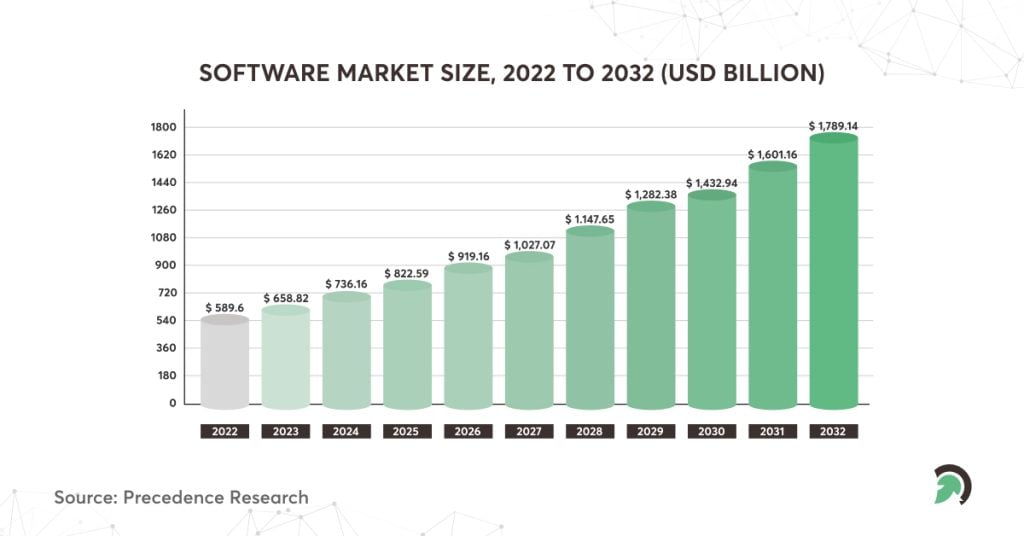Software development in 2026 is constantly growing and will continue in the coming months. Technological and societal needs drive many developments we’d likely see.
For example, the need for a secure way to execute contracts drives blockchain to the next level, while emerging AI applications require increased focus on “ethical AI” practices. Expanded use of VR and AR applications will also keep the industry evolving.
Many companies are adopting digital acceleration, and custom software development services from companies will help them conceive of new methods to drive their operations forward to benefit customers, society, and their bottom lines.
In the comprehensive guide, we’ll delve into the top 15 software development trends in 2025 to drive significant transformations in the industry.
Key Statistics in Software Development
Before diving into the software development trends, let’s take a detailed look at some key statistics that highlight the immense growth and potential of the global software market:
- Global IT spending is projected to reach $5.1 trillion in 2024, reflecting the increasing dependence on technology across industries.
- The global software market was projected to be USD 589.6 billion in 2022 and is predicted to increase at a CAGR of 11.74% to reach around USD 1,789.14 billion by 2032.

Top 15 Trends in Modern Software Development
Keeping informed with the latest software development trends in 2026 isn’t just about staying informed; it’s also about quickly adapting to evolving technologies and methodologies.
Therefore, to stay competitive and make well-informed decisions for your nearshore software development projects, it’s essential to be aware of the latest trends in the field. That’s why we’ve compiled a list of 15 software trends crucial for the success of your projects in today’s rapidly evolving tech world.
Now, let’s explore each trend in depth:
1. Artificial Intelligence & Machine Learning
AL and ML have emerged as transformative technologies in software development trends, enabling intelligent automation, predictive analytics, and personalized user experiences. From 2023 to 2030, the artificial intelligence industry is projected to expand at a CAGR of 36.8%, with a valuation of USD 150.2 billion.

AI-powered applications are increasingly integral to various industries, including healthcare, finance, retail, and manufacturing. From virtual assistants to chatbots to recommendation engines and fraud detection systems, AI and ML algorithms are revolutionizing how software is developed and utilized.
2. Low-Code and No-Code Development Platforms
Such platforms have changed software development by empowering citizens and business users to create applications with minimal coding expertise. They offer visual, drag-and-drop interfaces and pre-built components, accelerating development and reducing time-to-market.
By abstracting complex coding tasks, low-code and no-code platforms enable organizations to bridge the IT skills gap and foster innovation across departments.
As per research, low-code/no-code technologies will be used in 70% of new business processes by 2025.
The market for low-code platforms was estimated to be worth $7.61 billion in 2021. By 2027, it is anticipated to reach $36.43 billion. 80% of non-IT workers will create IT services and products by 2024, and more than 65% will do it with low- or no-code technologies.
3. DevOps and Continuous Integration/Continuous Delivery (CI/CD)
DevOps practices have been widely adopted in software development organizations, aiming to streamline collaboration between development and operations teams, automate the software delivery pipeline, and ensure rapid, reliable deployments. Companies implementing DevOps practices experience fewer failures and recover from failures 24 times faster than their peers.
CI/CD pipelines enable developers to continuously integrate code changes, run automated tests, and deploy applications to production environments with minimal manual intervention. By adopting DevOps principles, companies can achieve faster time-to-market, higher software quality, and increased business agility.
4. Internet of Things (IoT)
IoT has revolutionized how physical objects are connected and controlled, generating massive amounts of data that require innovative software solutions for device management, data analytics, and real-time insights. IoT-enabled applications span various domains, including smart homes, industrial automation, healthcare, agriculture, and transportation.

By utilizing IoT technologies, businesses can boost customer experiences, improve operational efficiency, and get new revenue streams.
By 2024, the IoT sector will be valued at over $1 trillion. Between 2019 and 2030, IoT revenue will continue to increase yearly in addition to IoT investment.
5. Blockchain Technology
The global blockchain technology sector is anticipated to increase at a CAGR of 67.3% from 2020 to 2026, pushed by the increasing demand for decentralized applications. The technology has disrupted traditional business models by offering secure, transparent, and decentralized solutions for transaction processing, data sharing, and digital asset management.
Beyond cryptocurrencies, blockchain applications span diverse industries, including finance, supply chain, healthcare, real estate, and government. Smart contracts, decentralized finance (DeFi), and non-fungible tokens (NFTs) are among the innovative use cases driving the adoption of blockchain technology worldwide.
6. Progressive Web Apps (PWAs) for Enhanced User Experience
As a prominent software development trend in 2024, businesses embracing Progressive Web Applications (PWAs) are experiencing remarkable results. With PWAs, companies observe a significant 137% surge in user engagement coupled with a notable 42.86% reduction in bounce rate. These applications amalgamate the finest attributes of both web and mobile apps, ensuring swift performance, offline functionalities, and fluid user experiences across various devices and platforms.
Progressive Web Apps utilize modern web application development technologies such as service workers, web app manifests, and responsive design to deliver app-like experiences directly through web browsers. By eliminating the need for app store distribution and enabling offline access, PWAs help businesses reach broader audiences and improve user engagement.
7. Cloud Computing
Cloud computing in 2024 has become the foundation for modern software development trends, providing scalable and cost-effective hosting, storage, computation, and service delivery infrastructure. The global public cloud services sector was predicted to grow by 18.4% in 2021, reaching $304.9 billion, driven by the shift to remote work and digital transformation initiatives.

Public, private, and hybrid cloud deployments offer flexibility, scalability, and accessibility, enabling organizations to innovate rapidly and respond to changing market demands. Cloud-native technologies, like serverless computing and containers, enhance agility, resilience, and resource utilization in software development processes.
8. Augmented Reality (AR) & Virtual Reality (VR)
AR and VR technologies are reshaping how people interact with digital content, upsetting the lines between the physical and virtual worlds. AR and VR applications span diverse industries and use cases, from immersive gaming experiences and virtual tours to training simulations and remote collaboration tools.
The worldwide market of AR and VR is expected to reach US$58.1 billion in 2028, growing at a rate of 10.77% between 2024 and 2028.
The growth of affordable AR/VR devices and development frameworks has democratized access to such technologies, fueling innovation and creativity in software development.
9. Microservices Architecture
Microservices architecture has become preferred for building scalable, modular, resilient software systems composed of small, independently deployable services. Companies adopting microservices witness a 20% reduction in time-to-market and a 60% increase in productivity.
Organizations can achieve greater agility, scalability, and fault isolation by decomposing monolithic applications into loosely coupled microservices. Microservices facilitate rapid iteration, deployment, and experimentation, allowing teams to deliver value to clients efficiently.
10. Big Data Analytics for Improved Decision-Making
As a prevailing software development trend, Big Data analytics revolutionizes how organizations harness insights from vast and intricate datasets. This technology facilitates data-driven decision-making, predictive modeling, and the delivery of personalized user experiences. Projections indicate substantial growth in the global big data market, with estimations suggesting it will more than double its value from the estimated figure 2018. By 2027, the market is anticipated to reach 103 billion US dollars, underscoring Big Data analytics’ escalating significance and adoption in diverse industries.
Big Data technologies offer myriad applications across retail, finance, healthcare, and marketing industries, from customer segmentation and trend analysis to anomaly detection and recommendation engines. Advanced analytics methods, such as NLP and machine learning, augment traditional BI tools, allowing organizations to uncover hidden patterns and the latest trends in their data.
11. Cybersecurity
With the increase in data breaches & cyber threats, cybersecurity has become essential for organizations developing software solutions. Secure coding practices, threat intelligence, vulnerability management, and compliance with industry standards are essential components of a robust cybersecurity strategy.
The global cybersecurity sector is anticipated to reach $298.5 billion by 2028, driven by increasing cyber-attacks and regulatory compliance requirements.
By integrating security measures into the software development lifecycle (SDLC) and adopting proactive defense mechanisms, businesses can mitigate risks, protect sensitive data, and safeguard against evolving cyber threats.
12. Voice-enabled applications and Natural Language Processing (NLP) technologies
The NLP market is anticipated to reach $68.1 billion globally by 2028, driven by the growth of virtual assistants and voice-activated devices. Voice-enabled applications powered by Natural Language Processing (NLP) technologies enable hands-free interaction, conversational experiences, and voice-based commands, enhancing accessibility and convenience for users.
13. Serverless Computing
The serverless architecture market is projected to increase at a CAGR of 22.7% from 2020 to 2026, driven by the demand for cost-effective and scalable solutions. Serverless computing abstracts infrastructure management and eliminates the need for provisioning, scaling, and maintaining servers, enabling developers to write code and deliver value to customers.

By utilizing Function-as-a-Service (FaaS) platforms, organizations can reduce operational overhead, optimize resource utilization, and achieve greater application scalability and elasticity. Function-as-a-Service (FaaS) platforms, an expanding software development trend, are well-suited for event-driven, ephemeral workloads like real-time data processing, IoT applications, and microservices.
14. Cross-Platform Frameworks Development
Cross-platform frameworks such as React Native, Flutter, and Xamarin enable developers to build applications that run across multiple platforms using a single codebase, including iOS, Android, and web browsers.
The market is expected to increase at a 16.7% CAGR during the following five years, reaching a value of US$ 546.7 billion by 2033.
One of the significant developments seen in 2023, which is expected to pick up speed in 2024, is the emergence of new tools facilitating the creation of user-friendly cross-platform development solutions. These tools aim to streamline development processes while reducing associated costs.
Such frameworks balance performance, user experience, and code maintainability, enabling organizations to reach broader audiences and maximize their market reach.
15. Agile Methodologies and Their Influence on Modern Software Development Practices
Agile methodologies have revolutionized software development, emphasizing iterative development, customer collaboration, and adaptive planning over rigid processes and documentation.
Organizations practicing agile methodologies experience a 64% improvement in project success rates and a 60% growth in profit and revenue.
Agile frameworks, such as Scrum, Kanban, and Extreme Programming (XP), promote cross-functional teams, frequent feedback cycles, and continuous improvement, enabling organizations to respond quickly to changing demands and deliver value to clients incrementally. By adopting agile software development, businesses can enhance transparency, flexibility, and productivity in their software development processes, fostering innovation and customer satisfaction.
Looking to Build The Software with Latest Trends?
As the software development industry evolves rapidly, driven by technological advancements, changing user expectations, and market dynamics, it’s crucial for businesses to stay ahead. EvinceDev is a leading custom software development company with expertise in the latest technologies and a dedication to delivering high-quality solutions tailored to your unique needs.
By focusing on collaboration, innovation, and customer-centricity, we allow businesses to transform ideas into reality, navigate digital breakdowns, and succeed in the digital age. Choosing EvinceDev as your trusted partner for software development sets you on a journey of innovation, transformation, and success.
Contact us for a FREE consultation for assistance regarding the perfect software solution for your specific requirements. Explore our offshore software development services and mobile app development services to realize your vision efficiently and effectively.





